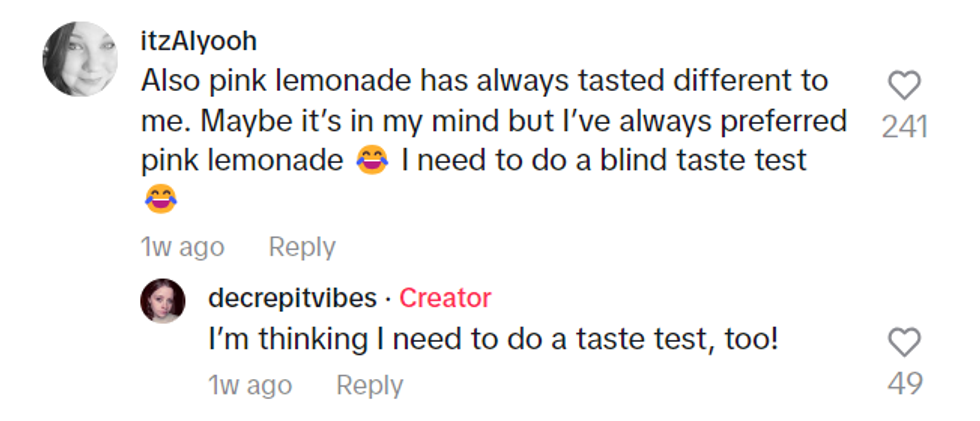As much as we might like to imagine that we know everything we could ever possibly need to know, it's simply impossible for us to know everything. There are bound to be some things we've just never questioned or been informed about, so when we suddenly discover the truth, it can come as a shock.
Unfortunately, sometimes that means being uninformed about the things we're putting into our bodies.
TikToker @decrepitvibes, for example, recently discovered that pink lemonade was not all she had thought it was.
She assumed that pink lemonade was made pink by adding other fruit juices, like strawberry, raspberry, watermelon, cherry, or maybe even grapefruit, to give it its color and flavor.
But after a quick Google search, the TikToker discovered that pink lemonade is not made pink naturally, but with the addition of food coloring. Some drink companies use Red Dye 40, a common food coloring addition that is FDA-approved but which is linked to allergies, migraines, and other issues in some consumers.
There are exceptions, of course, with some restaurants creating unique recipes, like strawberry lemonade that uses real strawberries, and some drink companies like Minute Maid use Red Dye 40 and grape juice, giving it that specific flavor and bubbly sensation that fresh-squeezed lemonade would not have.
You can watch the video here:
@decrepitvibes Big Lemon doesn’t want you to know this
Some were critical of the TikToker and questioned how she didn't know this sooner.






The TikToker pointed out that it was simply something that she had not learned before.
"It's common knowledge, I fear, but I just never looked into it, and no one ever told me, so I just didn't know."
@decrepitvibes Replying to @aifighter271 a little pink lemonade discourse to start the day
But others sided with the TikToker and assumed pink lemonade was pink because of other fruit juice.












The TikToker made a case for this logic, pointing out that this was true at some restaurants.
"I do see, understand, and accept that in different locations, a different fruit juice could be added to plain lemonade to make it pink but not really alter the flavor all that much."
@decrepitvibes Replying to @JoJo pink lemonade saga continues
One fellow TikToker continued to mess with the original poster, stating:
"Wait 'til you find out about blue raspberry and red velvet."
At that point, the TikToker decided she was done "figuring things out" for a while.
@decrepitvibes Replying to @weezy.elle in my Dark Age era. my year of not realizing things
This is one of those things that seems like it would be common sense to some people, but because we're not all following the exact same recipe, it really isn't as common sense as one might think.
It's easy to assume that if the product comes from the United States, it probably contains some additives and food dye, but that's usually in combination with natural food coloring and flavor.
Because the TikToker found examples of the pink color coming strictly from food coloring and not from other fruits at all, that may be where a lot of the confusion came from, which honestly, seems like a reasonable reaction. It seems reasonable to expect food color and flavor to come from, well, food.








 @PreetBharara/X
@PreetBharara/X @RepBrendanBoyle/X
@RepBrendanBoyle/X @twesq/Bluesky
@twesq/Bluesky @christopherharris/Bluesky
@christopherharris/Bluesky @evangelinewarren/X
@evangelinewarren/X






 @FrankC164/X
@FrankC164/X
 AMC
AMC